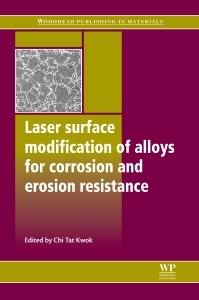Description
Laser Surface Modification of Alloys for Corrosion and Erosion Resistance
Woodhead Publishing Series in Metals and Surface Engineering Series
Coordinator: Kwok C T
Language: English
Subject for Laser Surface Modification of Alloys for Corrosion and...:
392 p. · 15.5x23.2 cm · Hardback
Out of Print
Description
/li>Contents
/li>Biography
/li>Comment
/li>
Contributor contact details
Introduction
Part I: Improving corrosion and cracking resistance
Chapter 1: Laser surface modification of steel and cast iron for corrosion resistance
Abstract:
1.1 Introduction
1.2 Laser surface treatments enhancing the corrosion resistance of ferrous alloys
1.3 Transformation and microstructure of laser-treated steels and cast irons
1.4 Applications: steel
1.5 Applications: cast iron and other materials
1.6 Acknowledgements
Chapter 2: Laser surface melting (LSM) to repair stress corrosion cracking (SCC) in weld metal
Abstract:
2.1 Introduction
2.2 Materials and experimental procedures
2.3 Laser surface melting (LSM) treatment conditions for repair procedures
2.4 Corrosion resistance of the laser surface melting (LSM) treatment zone
2.5 Effect of residual stress on stress corrosion cracking (SCC) susceptibility
2.6 Conclusions
Chapter 3: Laser surface melting (LSM) of stainless steels for mitigating intergranular corrosion (IGC)
Abstract:
3.1 Introduction
3.2 Merits of laser surface melting (LSM)
3.3 Laser surface modifcation of stainless steels for mitigating intergranular corrosion (IGC)
3.4 Experimental details
3.5 Metallographic and microstructural analysis
3.6 Intergranular corrosion (IGC) behavior
3.7 Conclusions
3.8 Acknowledgments
Chapter 4: Pulsed laser surface treatment of multilayer gold–nickel–copper (Au/Ni/Cu) coatings to improve the corrosion resistance of components in electronics
Abstract:
4.1 Introduction
4.2 Experimental arrangements
4.3 Experimental results
4.4 Numerical results
4.5 Conclusions
Chapter 5: Laser surface modification of nickel–titanium (NiTi) alloy biomaterials to improve biocompatibility and corrosion resistance
Abstract:
5.1 Introduction
5.2 Fundamental characteristics of nickel-titanium (NiTi)
5.3 Laser surface alloying of nickel–titanium (NiTi) with molybdenum (Mo)
5.4 Conclusion
Part II: Improving erosion-corrosion resistance
Chapter 6: Laser surface modification of metals for liquid impingement erosion resistance
Abstract:
6.1 Introduction
6.2 Experimental procedures
6.3 Coating characteristics
6.4 Liquid impact erosion characteristics
6.5 Eroded surface morphology
6.6 Correlation between mechanical properties and erosion resistance
6.7 Conclusions
6.8 Acknowledgments
Chapter 7: Laser surface modification of steel for slurry erosion resistance in power plants
Abstract:
7.1 Introduction
7.2 Surface engineering of hydroturbine steels
7.3 Materials and processes
7.4 Metallurgical performance of coatings
7.5 Slurry erosion performance of coatings: an overview
7.6 Impingement angle
7.7 Effect of erodent size
7.8 Effect of slurry velocity
7.9 Effect of slurry concentration
7.10 Erosion tests with river sand
7.11 Development of correlation for erosion rate
7.12 Conclusions
7.13 Acknowledgements
Chapter 8: Laser surface alloying (LSA) of copper for electrical erosion resistance
Abstract:
8.1 Introduction
8.2 Experimental details
8.3 Microstructural analysis
8.4 Hardness and strengthening mechanisms
8.5 Electrical erosion behavior and damage mechanism
8.6 Corrosion behavior
8.7 Interfacial contact resistance (ICR)
8.8 Conclusions
Acknowledgments
Chapter 9: Laser remanufacturing to improve the erosion and corrosion resistance of metal components
Abstract:
9.1 Introduction
9.2 Laser remanufacturing technology
9.3 Application of laser remanufacturing for corrosion and erosion resistance of turbine blades
9.4 Application of laser remanufacturing for corrosion and erosion resistance on injection molding machine screws
9.5 Application of laser remanufacturing for corrosion and erosion resistance of petrochemical system alkali filters
9.6 Application of laser remanufacturing for corrosion and erosion resistance of seawater circulating pump sleeves
9.7 Conclusions
Chapter 10: Laser surface remelting to improve the erosion–corrosion resistance of nickel–chromium–aluminium–yttrium (NiCrAlY) plasma spray coatings
Abstract:
10.1 Introduction
10.2 Need and role of post-coating treatments
10.3 Applications of laser remelted coatings to combat erosion and corrosion
10.4 Advantages of laser remelting
10.5 Role of nickel-chromium (Ni-Cr) coatings in aggressive environments
10.6 Experimental procedure
10.7 Experimental results
10.8 Conclusions
Index
- Reviews recent research on the use of laser surface modification techniques, including the prevention of corrosion and repair of corroded or damaged components
- Discusses the techniques for improving the corrosion resistance of steels, nickel-titanium and a range of alloys
- Analyses the use of laser surface modification to prevent different types of erosion, including liquid impingement and laser remanufacturing of damaged components




